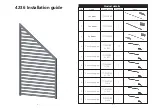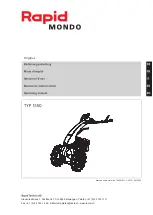
B200S-LF-WH, B200S-LF-IV
Low Frequency Intelligent Sounder Base
INSTALLATION AND MAINTENANCE INSTRUCTIONS
3825 Ohio Avenue, St. Charles, Illinois 60174
1-800-SENSOR2, FAX: 630-377-6495
www.systemsensor.com
BEFORE INSTALLING
Read System Sensor’s
Applications Guide for System Smoke Detectors
(SPAG91), which provides detailed information on sensor spacing, placement,
zoning, wiring, and special applications. This manual is available from System
Sensor. NFPA 72 and NEMA guidelines should be observed. The National Fire
Alarm Code, NFPA 72, requires effective January 1, 2014, that audible appli-
ances installed in sleeping areas produce a low frequency alarm signal that
shall be a square wave or provide equivalent awakening ability with a funda-
mental frequency of 520 Hz +/– 10%.
NOTE:
Select Series sounder bases are not compatible with remote test ca-
pable Select Series detectors.
NOTICE:
This manual should be left with the owner/user of this equipment.
IMPORTANT:
The detector used with this base must be tested and maintained
regularly following NFPA 72 requirements. The detector should be cleaned at
least once a year.
GENERAL DESCRIPTION
The B200S-LF-WH and B200S-LF-IV sounder bases are used with addressable
detector heads. For a list of compatible sensors, refer to the System Sensor
website at www.systemsensor.com. Refer to the appropriate manual for more
information on sensors.
The B200S-LF-WH/B200S-LF-IV low frequency sounder base generates a low
frequency tone around 520 Hz. Studies have shown that low frequency au-
dible devices that operate around 520 Hz are more effective in waking indi-
viduals in sleeping areas.
The sounder base is capable of producing a variety of tone patterns, includ-
ing the distinctive three-pulse temporal pattern (ANSI Temporal 3) fire alarm
signal now required by NFPA 72 for commercial and residential applications.
The B200S-LF-WH/B200S-LF-IV offers maximum flexibility in configuration
and operation to meet or exceed the requirements of UL268 and UL464 for
Continuous, Temporal 3 and March time patterns. The temporal 4 pattern
meets all requirements of UL268 and UL2075, as well as, private mode setting
of UL 464.
The B200S-LF-WH/B200S-LF-IV can be commanded by the Fire Alarm Con-
trol Panel (FACP) to adopt the address of the attached sensor head, but as
a unique device type on the loop. By using the address, the FACP can com-
mand an individual sounder base to activate, or a group of sounders in a suite
or other multi-room configuration. The command set from the panel can be
tailored to the specific event, allowing selection of volume, tone, and group.
The device offers two volume levels: 75 dBA and 85 dBA. The available tones
are Continuous, ANSI Temporal 3, ANSI Temporal 4, and March Time. In ad-
dition, some panels will offer the ability to command a custom tone pattern.
Refer to the appropriate FACP manual for more information.
SPECIFICATIONS
Base Diameter:
6.875" (17.46 cm)
Base Height (less sensor):
2.0" (5.08 cm)
Weight:
0.6 lb. (272 gm)
Operating Temperature Range: Refer to applicable sensor Operating Temperature Range using the Base/Sensor Cross Reference Chart at systemsensor.com
Operating Humidity Range:
10% to 93% relative humidity (non-condensing)
External Supply Electrical Ratings
External Supply Voltage:
16 to 33 VDC (VFWR)
Standby Current:
550 μA maximum VDC
Alarm Current:
High volume setting: 70 mA maximum @ 33.0 VDC
Low volume setting: 15 mA maximum @ 33.0 VDC
90 mA maximum @ 24.0 VDC
20 mA maximum @ 24.0 VDC
140 mA maximum @16.0 VDC
25 mA maximum @ 16.0 VDC
SLC Electrical Ratings
SLC Operating Voltage:
15 to 32 VDC
SLC Standby Current:
300 μA maximum (base only, refer to applicable sensor specification)
Sound Output
High Volume:
Greater than 85 dBA minimum measured in a UL reverberant room at 10 feet, 24 Volts (in continuous tone)
Low Volume:
Greater than 75 dBA minimum measured in a UL reverberant room at 10 feet, 24 Volts (in continuous tone)
In addition, the B200S-LF-WH/B200S-LF-IV is equipped with the circuitry to
recognize the System Sensor synchronization protocol, enabling the sounder
base to be used as a component of the general evacuation signal – producing
an NFPA 72 compliant Temporal 3 pattern in synchronization with other
System Sensor notification devices. This requires connection to a power
supply capable of generating the System Sensor synchronization pulses, a
FACP NAC output configured to System Sensor synchronization protocol, or a
separate synchronization module.
The sounder base is intended for use with intelligent systems. In addition to
being connected to the SLC, the sounder base requires a connection to either
24 VDC constant power or a NAC circuit, depending on the FACP and intended
use. The connections for 24V constant/NAC power and the communication
loop are isolated to prevent electrical interaction between them.
When connected to a NAC, power is supervised via the NAC circuit supervi-
sion while in standby mode (EOL resistor required for Class B operation).
When activated, the B200S-LF-WH/B200S-LF-IV provides supervision of NAC
power. (See Figure 5.)
When using a FACP equipped with a “sounder base standby power monitor-
ing” mode and constant 24 V power, power supervision EOL devices (super-
vision relays and resistors) should not be used. (See Figure 4.) In this case,
the B200S-LF-WH/B200S-LF-IV will provide supervision in both standby and
alarm/active mode. Refer to FACP installation documentation to determine if
this mode is available. If your FACP does not support this mode or you choose
not to use it, power supervision relays and EOL resistors are required to pro-
vide supervision in standby mode.
NOTE:
If the FACP’s “sounder base standby power monitoring” mode is en-
abled, connecting B200S-LF-WH/B200S-LF-IV low frequency sounder bases
to the NAC will result in power supervision failure when in standby. Only
connect B200S-LF-WH/B200S-LF-IV low frequency sounder bases to constant
24 V power in this case. Refer to the FACP manual for maximum allowable
number of units per loop.
NOTE:
For NFPA72 Installations, the Temporal 3 tone at high volume should
be used for public mode evacuation. The use of other tone styles and low
volume level will be at the discretion of the local Authority Having Jurisdic-
tion (AHJ).
NOTE:
When not used as a supplementary evacuation system, the external 24
VDC supply shall be treated as a component of the main power supply system
and shall fall under the requirements of the main power supply system per
NFPA 72.
I56-4
15
1-00
5
This model is compatible with System Sensor Models MDL, MDL3R, MDLW, MDL3W and SYNC-1
1
I56-4151-005
02/01/2018
firealarmresources.com






















